Neurobehavioral Effects and Toxicity Profile of Methanol Extract of Dialium guineense in Laboratory Animals
| Received 16 Feb, 2023 |
Accepted 10 Jun, 2023 |
Published 19 Jul, 2023 |
Background and Objective: Dialium guineenseis a medium-sized tree that is well distributed in Benin Republic, Cameroon, Gambia and Nigeria, is reported to have wide ethnomedicinal applications notably in fever, abdominal pain, anti-inflammatory, antimicrobial, antidiabetic and antiulcer-conditions. This study evaluated the phytochemistry, toxicity profile and central nervous system depressant effect of methanol leaf extract of Dialium guineense in mice and rats. Materials and Methods: The CNS depressant activities were evaluated using phenobarbitone-induced sleep, Hole-Board Test, Beam walking assay of motor coordination deficit and diazepam-induced sleep models. Results: The methanol leaf extract at 400 mg kg‾1 Dialium guineense significantly decrease the onset of sleep in mice (p<0.05). The extract also caused a significant (p<0.05) decrease in the number of head dips of mice in the Hole-Board Test. The methanol leaf extract of Dialium guineense significantly (p<0.05) increased the number of foot slips of mice in beam walk assay of motor coordination deficit. Also, there is no alteration in the haematological and biochemical markers of toxicity. Conclusion: The methanol leaf extract of Dialium guineense contains bioactive phytochemicals with central nervous system depressant activity and the toxicity studies indicated that it is relatively safe.
| Copyright © 2023 Jimoh et al. This is an open-access article distributed under the Creative Commons Attribution License, which permits unrestricted use, distribution, and reproduction in any medium, provided the original work is properly cited. |
INTRODUCTION
The prevalence of insomnia increases with age to the point that nearly half of the individuals aged 65 and over are affected at least a few nights per month1. These sleep disturbances are associated with daytime drowsiness that manifests as both persistent intentional and inadvertent naps and can result in impaired cognitive functioning and motor skills, diminished quality of life2 and increased consumption of health
care resources3. Benzodiazepine Receptor Agonists (BzRAs) such as diazepam, bromazepam and barbiturates are commonly used to treat insomnia in older patients4. Although their safety and efficacy have been established when used for short-duration therapy both in the younger5-9 and older population2, few data establish their continued efficacy and safety in long-term use. The lack of data supporting long-term therapy limits access to potentially effective treatment of a significant medical problem and hence the need to explore the medicinal plant archive for the discovery of a lead compound for future development of safer central nervous system depressant agents for the management of insomnia and other CNS disorders. These phytochemicals function alone or in conjunction with one another to produce the desired pharmacological effect10.
Dialium guineense is a tall, tropical fruit-bearing tree. It belongs to the family Leguminosae and has small, typically grape-sized edible fruits with brown hard inedible shells. Dialium guineense fruit coat is a black brittle outermost layer covering a more or less circular, flattened and sometimes glabrous pulp of about 2 cm in diameter11. It grows in dense forests in Africa along the Southern Edge of the Sahel. In Togo, it is called Atchethewh. The velvet tamarind can be found in West African countries such as Ghana where it is known as Yoyi, Sierra Leone where it is known as “Black tombla”, Senegal, Guinea-Bissau where because of its texture is called "Veludo", Portuguese for velvet and Nigeria where it is known as Awin or "Igbaru" in Yoruba, Icheku in Igbo and Tsamiyar kurma in Hausa. Each fruit typically has one hard, flat, round, brown seed, typically 7-8 mm across and 3 mm thick. The seed somewhat resembles a watermelon seed (Citrullus lanatus). Some have two seeds. The seeds are shiny, coated with a thin layer of starch. Wood is hard and heavy and used for construction. The wood is also used for firewood and charcoal production Gnansounou et al.12. The pulp is edible and may be eaten raw or soaked in water and consumed as a beverage. The bitter leaves are ingredients in a Ghanaian dish called Domoda. In Nigeria, the pulp is consumed raw or soaked in water and drank as a beverage while discarding the coat Martin et al.13. Dialium guineense leaf has been reported to possess sedative properties by traditional medicine practitioners and to the best of our knowledge, this claim (central nervous system depression effect) and the safety profile of the plant have not been proved scientifically. The aim of this research was to evaluate the central nervous system depressant activity of methanol leaf extract of Dialium guineense and establish its safety profile.
MATERIALS AND METHODS
Collection of plant material and preparation of extract: The plant was collected in Dange Shuni Local Government Area of Sokoto in June 2020, Sokoto State, Nigeria. The plant was identified and authenticated in the Department of Pharmacognosy and Ethnopharmacy, Faculty of Pharmaceutical Sciences Usmanu Danfodiyo University, Sokoto and was deposited in the herbarium voucher number PCG/UDU/DG/002. The leaves of Dialium guineense were shade dried. The dried leaves were pulverized to powder using a wooden pestle and mortar and then 500 g of the dried powder was weighed and subjected to cold maceration for 72 hrs with 95% methanol as the solvent of extraction, the mixture was allowed to stand for 5 hrs and was then shaken periodically. The whatman filter paper was used for the filtration of the mixture and the extract was concentrated in the water bath at 40°C. The dried extract was transferred to an air-tide container for storage.
Diazepam induced sleep: The method described by Alkali et al.14 and modified by Rakotonirina et al.15, was adopted. Briefly, twenty-four mice of either sex were obtained from the animal house, Faculty of Pharmaceutical Sciences, Ahmadu Bello University Zaria and were assigned into four groups, each containing six mice. The first group received 10 mL kg–1 of distilled water orally. The second, third and fourth groups received 100, 200 and 400 mg kg–1 orally of the Dialium guineense extract respectively. One-hour post-treatment, all the mice were treated with diazepam 30 mg kg–1 orally, the animals were observed and the onset and duration of sleep were recorded. Loss of righting reflex is considered as sleep onset and the time interval between loss of righting reflex and recovery to straightening was recorded as the duration of sleep.
Test for exploratory behavior in mice (Hole-Board Test): The method described by Pisula et al.16 was adopted. Briefly, the apparatus includes a white painted wooden board (60×30 cm) with 16 evenly spaced holes (1 cm diameter×2 cm depth). Thirty mice were randomly divided into 5 groups each containing six mice. The mice in the first group serve as the control which received 10 mL kg–1 of distilled water orally. The mice in the second, third and fourth groups received 100, 200 and 400 mg kg–1 orally of the extract respectively, while the mice in the fifth group received 30 mg of diazepam per kg body weight orally. One-hour post-treatment, each mouse was placed at a corner of the board and the number of head dips in the hole was counted using a tally counter for 5 min17.
Mice beam walking assay for motor in-coordination: The method described by Stanley et al.18 was adopted for this study. Briefly, adult mice were trained to walk from a start platform along a ruler (80 cm long, 3 cm wide) elevated 30 cm above the bench by metal support to a goal box. Three trials were performed for each mouse and were designed such that the mouse tested would be aware that there was a goal box that could be reached. The mice that successfully walked along the ruler were randomly grouped into five groups each containing six mice. The first group received 10 mL kg–1 of distilled water orally. The second, third and fourth groups received 100, 200 and 400 mg kg–1 of extract orally respectively. The fifth group received diazepam (30 mg kg–1 b.wt.).
Phenobarbitone induced sleep model: Briefly, thirty mice of either sex were assigned into five groups, each containing six mice. The first group received 10 mL kg–1 of distilled water orally. The second, third and fourth groups received 100, 200 and 400 mg kg–1 orally of the Dialium guineense extract respectively and the fifth group received diazepam. Thirty min after administration of the intervention or diazepam, phenobarbital (30 mg kg–1, i.p) is administered to all the animals to induce sleep. The interval between the loss and recovery of righting reflex is used as an index of hypnotic effect19.
Sub-chronic toxicity studies: The Organization for Economic and Community Development (OECD 407) method was adopted for the study20. The total number of animals: Twenty-four of either sex were randomly divided into four groups of six rats each (three males and three females). The first group received 10 mL kg–1 of distilled water orally. The second, third and fourth received 100, 200 and 400 mg kg–1 of Dialium guineense, respectively, daily for 28 days orally. The rats access food and water throughout the experiment (28 days). The observation was done on a daily basis for general symptoms of toxicity and mortality. The weights of the animals were taken weekly. On the 29th day, under light chloroform anesthesia, the animals were sacrificed. Blood samples were collected for haematological and biochemical tests. Histopathological examination was done on the spleen, liver and kidney.
Ethical consideration: Ethical clearance was obtained from the Department’s Committee and ethical standards were strictly observed in line with international standards and protocols in handling the animal subjects.
Statistical analysis: Results were expressed as Mean±Standard Error of Mean (SEM) and percentages. Data analysis was performed using SPSS statistical software (version 20). Comparison between groups was made using Analysis of Variance (ANOVA). When the statistical difference was obtained, a post hoc Dunnet’s Test was performed for multiple comparisons. Values of p<0.05 were considered significant.
RESULTS
Diazepam induced sleep: The methanol leaf extract of Dialium guineense significantly increased the duration of sleep induced by diazepam, with a duration of sleep in 100 mg kg–1 extract to 400 mg kg–1 extract lasting well over 9 to 12 min, while the duration of sleep in the distilled water control group only lasted about 7 min. There was no significant difference in the onset of sleep in all groups (Fig. 1).
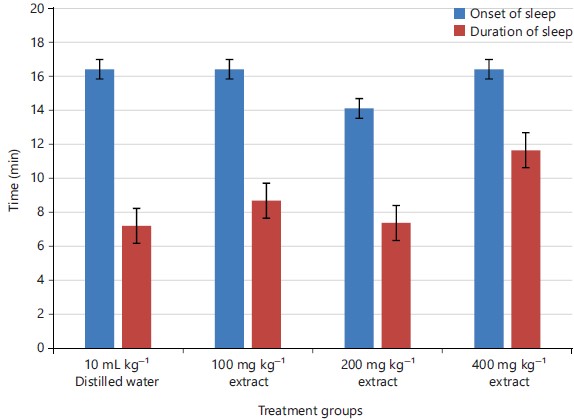
|
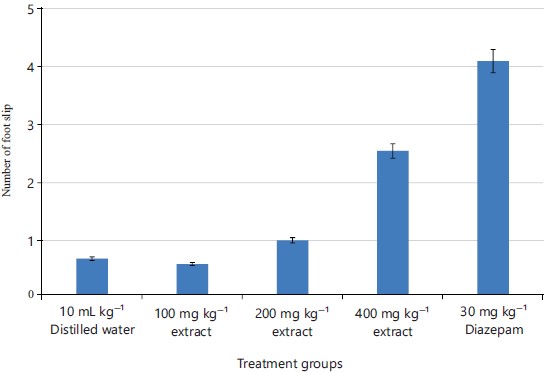
|
Beam walking assay model: The extract at the dose of 400 mg kg–1 has significantly increased the number of foot slips, with the extract at 400 mg kg–1 group having effects closely matching the positive control group (Diazepam 30 mg kg–1) (Fig. 2).
Hole-Board Test model: The extract has significantly reduced the number of head dips in a dose-dependent fashion, with the group at 400 mg kg–1 extract as effective as the positive control group (Diazepam 30 mg kg–1) (Fig. 3).

|
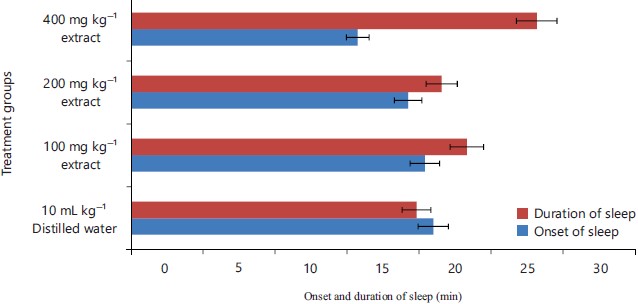
|
Phenobarbitone induced sleep mice model: The Dialium guineense 400 mg kg–1 methanol leaf extract has significantly increased the duration of sleep in the phenobarbitone induced sleep mice model to up to more than 25 min when compared to the negative control of about 17 min only (Fig. 4).
Effect of methanol leaf extract of Dialium guineense on haematological indices following 28 days of sub chronic oral treatment in albino rats: After 28 days of oral administration of methanol leaf extract of Dialium guineense, there was no significant (p<0.05) alteration in the haematological indices in all the extract-treated groups (100, 200 and 400 mg kg–1) compared with the control group treated with distilled water (Table 1).
Effect of methanol leaf extract of Dialium guineense on renal function indices following 28 days sub chronic oral treatment in albino rats: The result indicates a slight increase in urea in some groups, but the increase is not statistically significant, indicating the extract is relatively safe on renal tissue (Table 2).
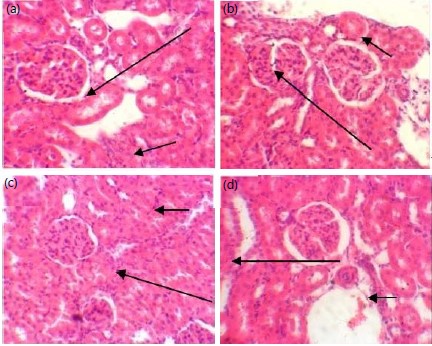
|
| Table 1: | Haematological indices following 28 days sub chronic oral administration of Dialium guineense | |||
| Treatment/dose (mg kg–1) | WBC (×103 μL) |
RBC (×103 μL) |
HGB (g dL–1) |
HCT (%) |
PLT (μL×103) |
MCV (fl) |
| Distilled water | 11.01±1.60 |
8.90±0.43 |
146.1±0.73 |
42.80±1.48 |
630.50±2.10 |
48.68±0.49 |
| 100 | 10.83±0.70 |
10.3±0.41 |
186.1±0.43 |
47.90±140 |
620.00±4.14 |
55.22±1.81 |
| 200 | 12.13±0.65 |
8.78±0.24 |
151.8±2.28 |
40.11±0.76 |
550.00±5.49 |
54.90±2.05 |
| 400 | 10.83±0.61 |
9.18±0.28 |
147.8±0.58 |
42.11±1.92 |
557.25±4.27 |
56.07±1.76 |
| Data expressed as Mean±SEM, SEM: Standard Error of Mean, n= 6, WBC: White Blood Cells, RBC: Red Blood Cells, HCT: Hematocrit, HGB: Hemoglobin, PCV: Packed Cell Volume, PLT: Platelet, MCV: Mean Cells Volume and Dunnett’s post hoc test significance level (p<0.05) | ||||||
| Table 2: | Renal function indices following 28 days subchronic administration of Dialium guineense | |||
| Treatment/dose (mg kg–1) | Urea (mmol) |
Creatinine (mmol) |
Na+ (mmol) |
K+ (mmol) |
Cl– mmol) |
HCO3 (mmol) |
| Distilled water | 5.31±0.10 |
1.08±0.13 |
137.66±1.88 |
3.61±0.19 |
103.0±2.25 |
24.50±1.32 |
| 100 | 6.43±0.21 |
1.06±0.08 |
139.16±2.53 |
3.90±0.10 |
102.8±2.05 |
24.33±1.37 |
| 200 | 5.66±0.17 |
1.01±0.06 |
139.33±2.90 |
3.98±0.10 |
106.6±2.78 |
24.16±1.84 |
| 400 | 6.38±0.22 |
1.45±0.85 |
138.55±1.97 |
4.28±0.21 |
102.8±4.17 |
24.50±1.70 |
| SEM: Standard Error of Mean, n = 6, Na+: Sodium ion, K+: Potassium ion, Cl–: Chloride ion, HCO3: Bicarbonate, Dunnett’s post hoc test and significance level (p<0.05) | ||||||
Effect of methanol leaf extract of Dialium guineense on liver function indices following 28 days of sub-chronic oral treatment in albino rats: There was no significant decrease or increase in all the liver function parameters following 28 days’ oral administration of (100, 200 and 400 mg kg–1) methanol leaf extract of Dialium guineense (Table 3).
Effect of methanol leaf extract of Dialium guineense on histology of the kidney following 28 days oral administration in rats: The result indicated regular glomerulus (long arrow) and renal tubules (short arrow) in the control group and also similar features were observed in the extract-treated groups (Fig. 5a-d).
Effect of methanol leaf extract of Dialium guineense on histology of the spleen following 28 days oral administration in rats: The result indicated regular red blood cell accumulation in the control group and also similar features were observed in the extract-treated groups (Fig. 6a-d).
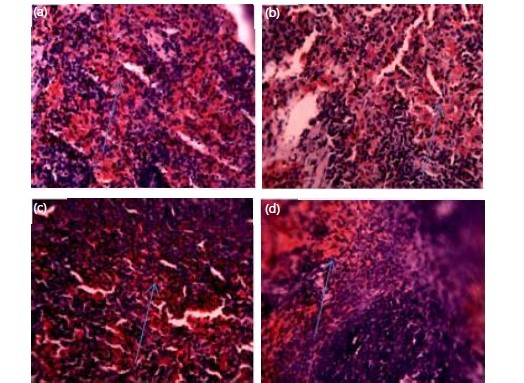
|
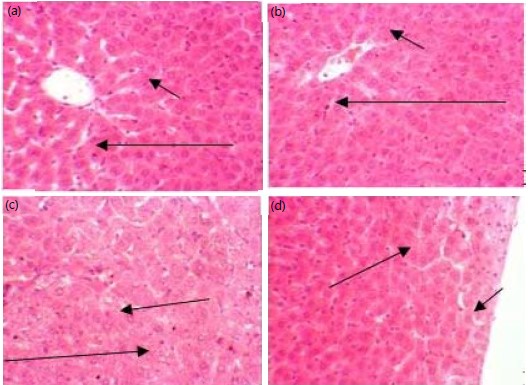
|
Effect of methanol leaf extract of Dialium guineense on histology of the liver following 28 days oral administration in rats: The liver section reveals a central vein (long arrow) and regular hepatocyte (short arrow) separated by a sinusoid. H&E×100 (Fig. 7a-d).
| Table 3: | Liver function indices following 28 days subchronic Dialium guineense | |||
| Treatment/dose (mg kg–1) | T.B (mg %) |
D.B (mg %) |
ALK (m L–1) |
AST (m L–1) |
ALT (m L–1) |
T.P (g L–1) |
Albumin (g L–1) |
| Distilled water | 0.81±0.06 |
0.26±0.04 |
79.33±2.56 |
7.33±3.08 |
6.50±2.10 |
61.16±2.56 |
38.16±1.04 |
| 100 | 0.81±0.06 |
0.25±0.01 |
75.16±2.42 |
6.83±1.58 |
9.00±2.32 |
62.83±3.12 |
39.00±2.49 |
| 200 | 0.83±0.11 |
0.31±0.04 |
74.16±2.42 |
6.66±2.42 |
7.33±3.79 |
60.66±1.10 |
39.16±2.01 |
| 400 | 0.80±0.06 |
0.25±0.06 |
62.33±6.30 |
6.50±2.17 |
7.66±2.68 |
61.66±3.75 |
37.66±1.08 |
| Data expressed as Mean±SEM, SEM: Standard Error of Mean, n = 6, T.B: Total Bilirubin, D.B: Direct Biluribin, ALK: Alkaline Phosphatase, AST: Aspartase Transaminase, ALT: Alanine Transaminase, T.P: Total Protein, Dunnett’s post hoc test and significance level (p<0.05) | |||||||
DISCUSSION
Plant’s chemical constituents constitute an indispensable part of medicinal plants and are responsible for their numerous bioactivities. The preliminary phytochemical screening of the methanol leaf extract of Dialum guineense revealed the presence of tannins, saponins, flavonoids, steroids, alkaloids, carbohydrates and reducing sugar. A significant number of plants containing a wide variety of phytochemicals as their bioactive principle have been reported to alter central nervous system activities21.
In the oral acute toxicity study of the plant extract, it was determined to be greater than 5000 mg kg–1 as no mortality was observed in both phases I and II of the Lork’s Method. According to Dietrich Lorke, 1 mg kg–1 is considered highly toxic, 10 mg kg–1 is considered toxic, 100 mg kg–1 is moderately toxic, 1000 mg kg–1 is slightly toxic and 5000 mg kg–1 is considered not toxic. The results indicate that large doses of the extract can be toxic and low doses are relatively safe. According to the American Society for Testing the Safety of Materials, any chemical substance with LD50 less than 2000 mg kg–1 oral route but greater than 1000 mg kg–1 oral could be considered to be slightly toxic.
Dialium guineense methanol leaf extract significantly prolonged the duration of sleep induced by diazepam with no significant effect on the onset. This action suggests that the Dialium guineense methanol leaf extract may possess central nervous system depressant properties. It has been reported that saponins show significant sedative activity when tested in similar models22. Alkaloids are the most important secondary metabolites in many plants that are held responsible for their sedative and anxiolytic action23.
This sedative-hypnotic property could be related to the presence of triterpenes. It was previously reported that triterpenes activate benzodiazepines, barbiturates and/or GABA receptors in the GABAA receptor complex24.
Dialium guineense methanol leaf extract significantly increased the number of foot slips by mice in the beam walk assay, increased foot slip indicates motor coordination deficit16. A similar finding was also reported by Magaji et al.25, who noticed a central nervous system depressant effect of a plant by its virtue to cause motor incoordination using beam walk assay22. While using a different plant to assay its neurobehavioral effects26. also reported no significant increase in the number of foot slips in the beam walking assay, suggesting that, the extract used does not possess a significant motor coordination deficit and this finding suggests the plant may be devoid of central nervous system depression. A similar finding was also reported by Aquirre-Hernandez et al.19.
Dialium guineense methanol leaf extract has significantly and dose-dependently decreased the number of head dips in the Hole-Board Test, indicating a decrease in exploratory behavior. As reported by Adzu et al.27, the hole board experiment is a measure of exploratory behavior in animals. A decrease in exploratory behavior indicates a central nervous system depressant effect. Similarly, Moniruzzaman et al.22, reported a different plant to possess a central nervous system depressant effect by decreasing the exploratory behavior of the experimental animals. Also, Adzu et al.27, has reported a different plant with a central nervous system depressant effect to decrease the number of head dips in the Hole-Board Test.
Dialium guineense methanol leaf extract significantly decreases the onset and extends the duration of phenobarbitone induced sleep, a similar result was also reported by Rout and Kar28.
Metabolic reactions in the body are largely regulated by the liver and kidney. The renal system is largely responsible for the excretion of waste products out of the body. The liver detoxifies substances that are harmful to the body while the kidney helps in maintaining homeostasis by reabsorbing vital electrolytes and excretion of waste products.
Urea and creatinine are the major indicators of renal toxicity. Serum urea accumulation is used as the acute marker, while serum creatinine accumulation is used in detecting chronic renal toxicity29. In this study, the oral administration of Dialium guineense extract for 28 days did not produce significant alteration in the renal function indices. The histological section of the rats indicates normal glomeruli and regular renal tubules. A similar finding was also reported by Akinrinde et al.30, who assayed the renoprotective effects of Moringa oleifera leaf extract on the kidneys of adult Wistar rats and observed no alteration in the renal function indices and no tissue lesion in the histopathology study.
The degree of liver damage induced by a chemical substance can be evaluated by determining the level of biochemical markers of the liver function, specifically the liver enzymes, such as Aspartate Transaminase (AST) and Alanine Transaminase (ALT), Alkaline Phosphatase (ALP). The ALP is located in the cytoplasm and is released into circulation after cellular hepatic damage. The ALT and AST are also enzymes released as a result of liver injury, especially damage to the mitochondria of liver cells. Elevation of the level of these enzymes can be an indication of cellular damage, leakage and loss of functional integrity of the hepatic cell membrane. The result of this study reveals no significant differences in the level of liver enzyme when Dialium guineense extract-treated groups are compared with the control group. Also, the histology section reveals a normal central vein and regular hepatocyte separated by a sinusoid. Dialium guineense methanol leaf extract can be relatively safe at a low dose, however, contradicting findings was reported by Peter et al.31, who used different plant and discovered an increase in serum concentration of ALT and ALP. The histological study of the harvested liver showed hepatocytes degeneration and periportal inflammations indicating an alteration in the normal physiological status of the liver.
The hematopoietic physiology is very sensitive to toxins, hence values obtained after exposure of an animal to toxic compounds can be used to evaluate the pathological or physiological status of the test animal32.
After 28 days’ administration of different doses (100, 200 and 400 mg kg–1 b.wt.) of Dialium guineense methanol leaf extract there was no significant difference in RBC and indices relating to it (Hb, HCT and MCV) throughout the experimental period is an indication that there was no destruction of red blood cell and no change in the rate of production of the RBCs. This also reveals that the extract of Dialium guineense does not stimulate the release of erythropoietin from the renal system, which is the humoral regulator of RBC production33.
Also, Tohti et al.34, has reported a decrease in the white blood cell count (WBC) due to the presence of some phytochemicals such as Saponins and Cardiac Glycosides34. This decrease may also suggest the extract’s inhibitory effect on white blood cell production, possibly by decreasing thrombopoietin secretion. White blood cells function mainly to fight infection and produce and transport antibodies to various body compartments. The leaf extract of the tested compound possesses substances with CNS depressant effects with relative safety.
These substances from the plant extract responsible for CNS depressant activities can be further processed in CNS depressant drug discovery. The inability of the authors to carry out molecular studies on the extract. Active chemicals should be isolated and characterized and the mechanism of action should be determined.
CONCLUSION
It may be concluded that the methanol leaf extract of Dialium guineense contains bioactive phytochemicals with central nervous system depressant effects. The toxicity studies of the methanol leaf extract of Dialium guineense indicate relative safety, caution needs to be taken when using a higher dose for a long period.
SIGNIFICANCE STATEMENT
This study discovers the central nervous system depressant effect of Dialium Guineense that can be beneficial for subjects suffering from insomnia. This study will help the researcher to uncover the critical area of internal organ toxicity that many researchers were not able to explore and it presents a challenging obstacle that failed many lead compounds. Thus, a new theory necessitating the exploration of both the efficacy and safety profile of promising extract might emerge.
REFERENCES
- Neikrug, A.B. and S. Ancoli-Israel, 2010. Sleep disorders in the older adult-A mini-review. Gerontology, 56: 181-189.
- Patel, D., J. Steinberg and P. Patel, 2018. Insomnia in the elderly: A review. J. Clin. Sleep Med., 14: 1017-1024.
- Ustinov, Y., K.L. Lichstein, G.S.V. Wal, D.J. Taylor, B.W. Riedel and A.J. Bush, 2010. Association between report of insomnia and daytime functioning. Sleep Med., 11: 65-68.
- Shochat, T., J. Loredo and S. Ancoli-Israel, 2001. Sleep disorders in the elderly. Curr. Treat. Options Neurol., 3: 19-36.
- Mooney, J.J., P.S. Pagel and A. Kundu, 2014. Safety, tolerability, and short-term efficacy of intravenous lidocaine infusions for the treatment of chronic pain in adolescents and young adults: A preliminary report. Pain Med., 15: 820-825.
- Krystal, A.D., H.H. Durrence, M. Scharf, P. Jochelson, R. Rogowski, E. Ludington and T. Roth, 2010. Efficacy and safety of doxepin 1 mg and 3 mg in a 12-week sleep laboratory and outpatient trial of elderly subjects with chronic primary insomnia. Sleep, 33: 1553-1561.
- Fry, J., M. Scharf, R. Mangano and M. Fujimori, 2000. Zaleplon improves sleep without producing rebound effects in outpatients with insomnia. Int. Clin. Psychopharmacol., 15: 141-152.
- Weitzel, K.W., J.M. Wickman, S.G. Augustin and J.G. Strom, 2000. Zaleplon: A pyrazolopyrimidine sedative-hypnotic agent for the treatment of insomnia. Clin. Ther., 22: 1254-1267.
- Poceta, J.S., 2011. Zolpidem ingestion, automatisms, and sleep driving: A clinical and legal case series. J. Clin. Sleep Med., 7: 632-638.
- Parasuraman, S., G.S. Thing and S.A. Dhanaraj, 2014. Polyherbal formulation: Concept of ayurveda. Pharmacogn. Rev., 8: 73-80.
- Okeke, N.C., T.K. Udeani and U.L. Onyebuchi, 2016. Wound-healing and antimicrobial properties of dichloromethane fraction of Dialium guineense (Wild) fruit coat. Res. Pharm. Sci., 11: 219-226.
- Gnansounou, M.S., S. Iskandar, M. Robin, J.M. Brunel, E. Dahouenon and P. Piccerelle, 2018. Dialium guineense Willd. Parkia biglobosa (Jacq.) R. Br. Ex Benth. and Tamarindus indica L.: Review of known and synergetic bioactive compounds. J. Med. Plants Stud., 6: 103-111.
- Martin, F.W., C.W. Campbell and R.M. Ruberté, 1987. Perennial Edible Fruits of the Tropics: An Inventory. U.S. Dept. of Agriculture Agricultural Research Service, Washington, D.C., Pages: 247.
- Alkali, Y.I., A.O. Jimoh, K. Abubakar and Y. Musa, 2018. Antischizophrenic and central nervous system depressant effects of methanol leaf extract of Cassia singueana (Fransen) in Wistar rats and mice. Aust. J. Sci. Technol., 2: 163-168.
- Rakotonirina, V.S., E.N. Bum, A. Rakotonirina and M. Bopelet, 2001. Sedative properties of the decoction of the rhizome of Cyperus articulatus. Fitoterapia, 72: 22-29.
- Pisula, W., K. Modlinska, K. Goncikowska and A. Chrzanowska, 2021. Can the hole-board test predict a rat’s exploratory behavior in a free-exploration test? Animals, 11: 1068.
- Brown, G.R. and C. Nemes, 2008. The exploratory behaviour of rats in the hole-board apparatus: Is head-dipping a valid measure of neophilia? Behav. Processes, 78: 442-448.
- Stanley, J.L., R.J. Lincoln, T.A. Brown, L.M. McDonald, G.R. Dawson and D.S. Reynolds, 2005. The mouse beam walking assay offers improved sensitivity over the mouse rotarod in determining motor coordination deficits induced by benzodiazepines. J. Psychopharmacol., 19: 221-227.
- Aguirre-Hernandez, E., A.L. Martinez, M.E.G. Trujano, J. Moreno, H. Vibrans and M. Soto-Hernandez, 2007. Pharmacological evaluation of the anxiolytic and sedative effects of Tilia americana L. var. mexicana in mice. J. Ethnopharmacol., 109: 140-145.
- OECD, 2008. Test No. 407: Repeated Dose 28-Day Oral Toxicity Study in Rodents. In: OECD Guidelines for the Testing of Chemicals, Section 4, OECD, OECD Publishing, Malaysia, ISBN: 9789264070684, Pages: 1-13.
- Fokoua, A.R., M.K. Ndjenda, A.K. Wuyt, F.D.T. Bomba and A.K. Dongmo et al., 2021. Anticonvulsant effects of the aqueous and methanol extracts from the stem bark of Psychotria camptopus Verdc. (Rubiacaea) in rats. J. Ethnopharmacol., 272: 113955.
- Moniruzzaman, M., M.A. Rahman and A. Ferdous, 2015. Evaluation of sedative and hypnotic activity of ethanolic extract of Scoparia dulcis Linn. Evidence-Based Complementary Altern. Med., 2015: 873954.
- Elisabetsky, E. and L. Costa-Campos, 2006. The alkaloid alstonine: A review of its pharmacological properties. Evidence Based Complementary Altern. Med., 3: 39-48.
- Banerjee, S., C. Manisha, D. Murugan and A. Justin, 2021. Natural Products Altering GABAergic Transmission. In: Natural Medicinal Plants, El-Shemy, H. (Ed.), IntechOpen, London, UK, ISBN: 978-1-83969-276-5, pp: 1-23.
- Magaji, M.G., J.A. Anuka, I. Abdu-Aguye, A.H. Yaro and I.M. Hussaini, 2008. Behavioural effects of the methanolic root bark extract of Securinega virosa in rodents. Afr. J. Tradit. Complementary Altern. Med., 5: 147-153.
- Magaji, M.G., A.H. Yaro, A.M. Musa, J.A. Anuka, I. Abdu-Aguye and I.M. Hussaini, 2012. Central depressant activity of butanol fraction of Securinega virosa root bark in mice. J. Ethnopharmacol., 141: 128-133.
- Adzu, B., S. Amos, S. Dzarma, C. Wambebe and K. Gamaniel, 2002. Effect of Ziziphus spina-christi Willd aqueous extract on the central nervous system in mice. J. Ethnopharmacol., 79: 13-16.
- Rout, S.K. and D.M. Kar, 2013. Sedative, anxiolytic and anticonvulsant effects of different extracts from the leaves of Ipomoea carnea in experimental animals. Int. J. Drug Dev. Res., 5: 232-243.
- Borges, L.P., V.C. Borges, A.V. Moro, C.W. Nogueira, J.B.T. Rocha and G. Zeni, 2005. Protective effect of diphenyl diselenide on acute liver damage induced by 2-nitropropane in rats. Toxicology, 210: 1-8.
- Akinrinde, A.S., O. Oduwole, F.J. Akinrinmade and F.B. Bolaji-Alabi, 2020. Nephroprotective effect of methanol extract of Moringa oleifera leaves on acute kidney injury induced by ischemia-reperfusion in rats. Afr. Health Sci., 20: 1382-1396.
- Peter, A., N. Bestman and K.U. Nwoke, 2015. Effects of ethanolic extract of Cyperus esculentus (tiger nut) on some liver function parameters using albino Wistar rats. J. Pharm. Med. Res., 2: 1705-1715.
- Krewski, D., D. Acosta, M. Andersen, H. Anderson and J.C. Bailar et al., 2010. Toxicity testing in the 21st Century: A vision and a strategy. J. Toxicol. Environ. Health Part B, 13: 51-138.
- Schmauss, C. and J.R. Howe, 2002. RNA editing of neurotransmitter receptors in the mammalian brain. Sci. STKE, 2002: 133.
- Tohti, I., M. Tursun, U. Anwar, S. Turdi, H. Imin and N. Moore, 2006. Aqueous extracts of Ocimum basilicum L. (sweet basil) decrease platelet aggregation induced by ADP and thrombin in vitro and rats arterio-venous shunt thrombosis in vivo. Thromb. Res., 118: 733-739.
How to Cite this paper?
APA-7 Style
Jimoh,
A.O., Fredrick,
O.N., Tukur,
U.M., Hudu,
S.A., Alkali,
Y.I. (2023). Neurobehavioral Effects and Toxicity Profile of Methanol Extract of Dialium guineense in Laboratory Animals. Pharmacologia, 14(1), 50-60. https://doi.org/10.17311/pharma.2023.50.60
ACS Style
Jimoh,
A.O.; Fredrick,
O.N.; Tukur,
U.M.; Hudu,
S.A.; Alkali,
Y.I. Neurobehavioral Effects and Toxicity Profile of Methanol Extract of Dialium guineense in Laboratory Animals. Pharmacologia 2023, 14, 50-60. https://doi.org/10.17311/pharma.2023.50.60
AMA Style
Jimoh
AO, Fredrick
ON, Tukur
UM, Hudu
SA, Alkali
YI. Neurobehavioral Effects and Toxicity Profile of Methanol Extract of Dialium guineense in Laboratory Animals. Pharmacologia. 2023; 14(1): 50-60. https://doi.org/10.17311/pharma.2023.50.60
Chicago/Turabian Style
Jimoh, Abdulgafar, Olayiwola, Ohanu Ngozi Fredrick, Umar Mohammed Tukur, Shuaibu Abdullahi Hudu, and Yusuf Ibrahim Alkali.
2023. "Neurobehavioral Effects and Toxicity Profile of Methanol Extract of Dialium guineense in Laboratory Animals" Pharmacologia 14, no. 1: 50-60. https://doi.org/10.17311/pharma.2023.50.60

This work is licensed under a Creative Commons Attribution 4.0 International License.



